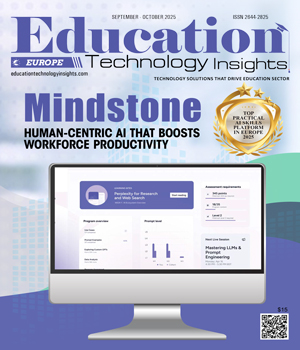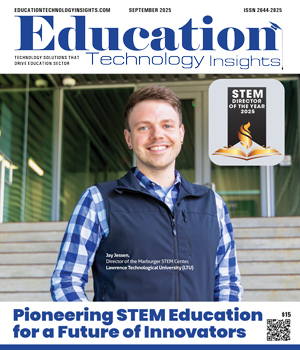THANK YOU FOR SUBSCRIBING
Be first to read the latest tech news, Industry Leader's Insights, and CIO interviews of medium and large enterprises exclusively from Education Technology Insights
Building Resilience in the Age of Cyber Threats
Dr. Frederic Lemieux, Faculty Director, Master’s in AI Management, Georgetown University
 Dr. Frederic Lemieux, Faculty Director, Master’s in AI Management, Georgetown University
Dr. Frederic Lemieux, Faculty Director, Master’s in AI Management, Georgetown UniversityDr. Frederic L., based in the Washington DC-Baltimore area, has over 20 years of experience in developing and delivering degree programs and training for security professionals. He is a faculty director at Georgetown University for multiple master's programs in AI Management, Applied Intelligence, IT Management, and Cybersecurity Risk Management and serves as CEO of A.S.S.E.T. Consulting. He is an expert in intelligence, cybersecurity, blockchain, AI, and has published extensively on law enforcement, homeland security, and disruptive technologies. Dr. L. is also a frequent keynote speaker and advisor to governments and corporations worldwide.
For the Magazine Education Technology Insights he shared invaluable insights on how adaptive learning, AI, and secure digital ecosystems are reshaping the future of higher education.
1. Can you share your career journey and the key experiences that influenced your philosophy and led you to your role at Georgetown University?
My career journey began with an early fascination for intelligence and security studies, which paved the way for a doctoral degree in criminology at the University of Montreal. This academic foundation led me through diverse roles at both the University of Montreal and George Washington University, where I launched innovative programs in policing, homeland security, and cybersecurity. The culmination of these experiences has shaped my philosophy: impactful education must combine theoretical grounding with practical, forward-looking skills. At Georgetown University, my role as Faculty Director allows me to merge research, practice, and leadership, ensuring that our programs are responsive to the evolving demands of AI, cybersecurity, and national security policy. My guiding principle is to turn disruption into opportunity, preparing learners not just to adapt, but to lead change even if this feels uncomfortable.
2. How do you balance the need for robust security measures with the user experience, ensuring that solutions are both effective and practical?
I balance robust security measures with user experience by championing solutions that protect both user data and the integrity of academic processes, without sacrificing accessibility. This often means deploying multi-factor authentication and least-privilege access protocols behind streamlined, intuitive interfaces such as single sign-on portals and adaptive authentication systems. I firmly believe that true security is invisible, empowering users to teach, learn, and innovate seamlessly, while minimizing friction and maintaining trust.
“True impact comes from blending theory with practice, embracing disruption as opportunity, and equipping learners with adaptive skills to lead confidently in security, AI, and innovation”
3. Within a field where many training programs tend to focus heavily on static theory, how do you intentionally build in flexibility and rapid relevance into your course design?
To create flexible, relevant programs, I leverage modular curricula and real-world case studies that highlight emerging cyber threats and AI trends. Our course design is intentionally adaptive, incorporating up-to-date threat intelligence, practical simulations, and AI-powered learning tools that personalize paths for diverse learners. This approach keeps content agile and directly responsive to industry shifts, ensuring students graduate with skills that are immediately applicable and continually refreshed. In addition to adaptive curricula and case-based content, I rely on leading experts who are working professionals to teach many of our courses, bringing the real world directly into the classroom. This approach ensures that students not only receive theoretical knowledge but also gain insights from instructors actively engaged with current AI and cybersecurity challenges in the workforce. The connection to industry leaders means that our program remains highly flexible and rapidly relevant, equipping learners to handle urgent, complex issues from day one.
4. With the rise of cyberwarfare, misinformation campaigns and geopolitical tension, what should universities and governments be doing today to prepare their teams for tomorrow’s realities?
In the face of escalating cyberwarfare and misinformation, universities and governments must invest in intelligence-driven education, robust scenario-based training, and policies that foster both technical skill and critical thinking. I advocate for wargaming exercises and the integration of cyber threat simulations, enabling teams to anticipate, analyze, and counter evolving adversarial tactics. Institutional resilience is built on proactive collaboration, continuous learning, and strong ethical frameworks, arming communities to resist manipulation at scale. To address the next major challenge, I highlight the urgent need for universities and organizations, especially across the critical infrastructure sectors, to become aware of and prepare for the risks associated with post-quantum encryption. The advent of quantum computing is poised to undermine many current encryption methods, yet there is a notable lack of awareness and readiness in critical fields like energy, finance, and transportation. I advocate for immediate education, strategic planning, and coordinated migration to quantum-safe cryptographic standards to future-proof sensitive systems, as postponing these efforts could leave vital infrastructure dangerously exposed to quantum-enabled threats.
5. How do you balance your roles as a researcher, consultant and keynote speaker to maximize your impact on the industry?
Balancing my roles as a researcher, consultant, and keynote speaker relies on integrating lessons from each domain into my teaching and thought leadership. I maximize impact by staying rooted in real-world challenges: consulting informs my research questions; research shapes my conference presentations; and every keynote is an opportunity to inspire both practitioners and policymakers with actionable insights. This synergy amplifies my contributions and keeps my perspective multi-dimensional. For example, in my role as a keynote speaker, a presentation on cognitive heuristics, artificial intelligence, and past intelligence failures directly inspired the development of a specialized decision-support tool for intelligence analysis. This keynote highlighted how unconscious cognitive biases, such as the hidden assumptions and confirmation bias, can unintentionally mislead decision makers, particularly in high-stakes intelligence environments. Recognizing this, I collaborated with AI experts to develop a tool that leverages machine learning to help intelligence professionals systematically flag patterns of bias, increase analytic objectivity, and provide balanced perspectives across diverse data sources. By combining automated anomaly detection with structured human judgment, this solution helps analysts to deliver more accurate, reliable assessments and better protect decision makers from the pitfalls of intuition-driven errors.
6. what advice would you give to organizations looking to build a culture of resilience and innovation in the face of evolving security challenges?
My key advice to organizations is to embrace change, define core values, and sustain open, transparent communication. Resilient cultures are forged through continuous learning, strategic planning, and leadership that empowers employees at every level. Innovation flourishes when people understand not just what is expected of them, but why their work matters, particularly in times of disruption. Digital workplaces, knowledge-sharing platforms, and scenario-based training all play vital roles in fostering adaptability and future-proofing security and talent pipelines.
Read Also
From At-Risk to At-Promise: The Language Revolution Higher Education Needs
Teaching Tomorrow: How Western Governors University Is Redefining Teacher Preparation
Shaping Future Engineers Through Innovation and Hands-On Learning
From Isolation to Interaction: Reimagining Technology for Human Connection
Building an Understanding of AI in Learning Environments
Integrating SEL, Digital Citizenship, and AI Literacy in K–8 Schools

I agree We use cookies on this website to enhance your user experience. By clicking any link on this page you are giving your consent for us to set cookies. More info

However, if you would like to share the information in this article, you may use the link below:
www.educationtechnologyinsightseurope.com/cxoinsights/dr-frederic-lemieux-nid-3416.html





















